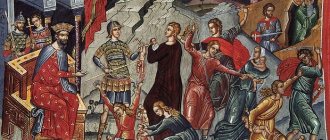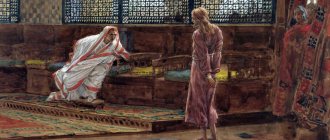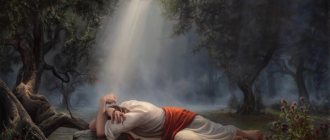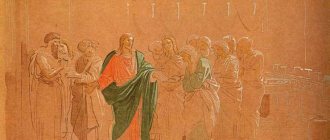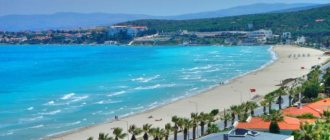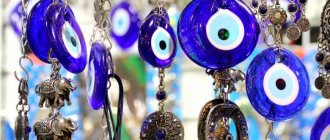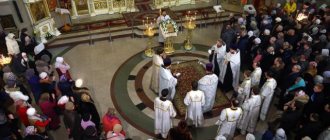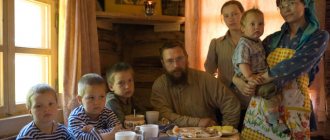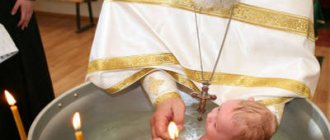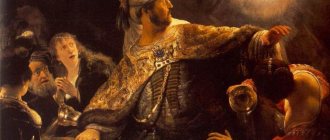"ESCAPE TO EGYPT"
Joseph's Dream and Flight to Egypt. Mosaic of the exonarthex of the temple of the Hora monastery (Kakhrie-jami) in K-pol. XIV century
Joseph's Dream and Flight to Egypt. Mosaic of the exonarthex of the temple of the Hora monastery (Kakhrie-jami) in K-pol. XIV century A story about an event from the childhood of Jesus Christ, found only in the Evangelist Matthew (Matthew 2. 13-15). The Magi, who came from the East to worship the born King (Matthew 2:1-11), received a revelation from an angel in a dream and left for their country without revealing to Herod the whereabouts of the Child (Matthew 2:12). This infuriated the ruler of Palestine, who gave the order to kill all infants under two years of age in Bethlehem and its environs (Matthew 2:16). In a dream, the Angel of the Lord informs Joseph about the danger threatening the Savior and commands him, taking Mary and the Child, to flee to Egypt, which since ancient times was considered a place of refuge (1 Kings 11.40; 2 Kings 25.26). The Evangelist does not provide additional details of this journey, except that the Holy Family was in Egypt until the death of Herod (Matthew 2.15), and after the accession of Archelaus they returned to the Holy Land, settling in the remote, but safer Galilee (Matthew 2.15). 19-23).
The Evangelist Luke, who described in detail the story of the birth of Christ, does not mention this episode, which may be explained by his general theological intent. Description of the impotent anger of Herod and “B. in E." do not fit into the context of the constant praise of God in the first chapters of the Gospel of Luke. For the Evangelist Matthew, who writes for Christians converted from Jews, it was important to show that Jesus of Nazareth is the Promised Messiah whom the Old Testament prophets predicted. This explains the numerous references to prophecies fulfilled in Christ. One of them, according to the Evangelist Matthew, is the one he quotes from Heb. The text contains an excerpt from the Book of the Prophet Hosea (11.1): “Out of Egypt I called My Son [LXX: “sons” - τὰ τέκνα].” Prophet Hosea, complaining about the hard-heartedness of his compatriots, reminds them of the events of liberation from Egypt. slavery. The New Testament author sees in the words of the prophet one of the predictions about Christ. Israel, the firstborn of God (Exodus 4.22; cf. Jer 31.9), typifies the beloved Son of God (cf. Matt. 3.17). The parallel with the events of the Exodus is strengthened by the comparison of Jesus Christ with Moses the Lawgiver. As in the Old Testament, the baby Moses miraculously escaped the wrath of Egypt. Pharaoh (Exodus 1-2), and in the NT, by the direct command of God, the Baby Jesus was saved from the wrath of King Herod. Just as Moses once led the chosen people out of the land of slavery (cf. Exodus 20.2), so now the New Moses (cf. Deut. 18.15-18) must lead the New Israel, His Church, out of the land of sin. The flight and return of Christ from Egypt not only reveals the true meaning of one of the episodes in the history of Israel, but in the fulfillment of ancient prophecy, the New Testament event itself becomes a typological figure of future achievements. This interpretation will also be found among some St. fathers (see, for example, Ioan. Chrysost. In Matt. 8. 2).
Flight to Egypt. Copt. icon. XVIII century (Ts. al-Mualaka in Cairo)
Flight to Egypt. Copt. icon. XVIII century (Ts. al-Mualaka in Cairo) The story of “B. in E." reflected in early Christ. and apocryphal literature. But if in the first case, from a simple repetition of certain details of the canonical Gospel text, there is a gradual transition to detailed exegetical comments, then in the second, an attempt is made to fill in events not mentioned in the Gospel. Already in the 2nd century. according to R.H. martyr. Justin the Philosopher mentions “B. in E." as a generally known fact (Dial. 78, 4). This plot is also addressed by schmch. Hippolytus of Rome (In Matth. 24) and Irenaeus of Lyons (Adv. haer. III 9. 2; IV 20. 12; IV 23. 1). The use of this plot by Origen is distinguished by its polemical orientation, who, in particular, disputes the daring statement of the pagan Celsus that “Jesus grew up as an illegitimate child, worked for hire in Egypt, acquired certain magical abilities there, and then returned to His homeland and used these abilities to proclaim Himself God” (Contra Cels. 1.38). ABOUT. in E." Church historians also mention it: Eusebius of Caesarea (Hist. ecсl. I 8.2; Demonstratio evangelica IX 4, 2) speaks of him in connection with the history of Egypt. Christianity, and Sozomen calls the place of stay of the Holy Family in Egypt the city of Hermopolis (Hist. eccl. V 21).
Return of St. Families to Jerusalem. Copt. icon. Con. XVII - beginning XVIII century
Return of St. Families to Jerusalem. Copt. icon. Con. XVII - beginning XVIII century Along with the church tradition of interpretation of this plot, extensive apocryphal literature appears, which contains numerous facts not found in the canonical Gospel. The Gospel of Pseudo-Matthew describes the worship of the Infant Jesus by dragons (18), wild beasts (19) and plants (20-21), as well as a miraculous shortening of the difficult journey to a distant land (22). In Arab. The “Gospel of Childhood” tells of numerous healings performed by Christ in Egypt (14-19), and of his breaking witchcraft spells (20-22). In the 23rd chapter of this apocrypha there is a story about how the Holy Family was attacked by 2 robbers, one of whom, seeing the beauty of the Baby, begged his friend to let the travelers through without causing them any harm. The apocrypha tells that Christ predicted that both of them would be crucified with Him on Golgotha and one of them would be a repentant thief (in the text his name is given - Titus, according to another version - Dismas). The same apocrypha indicates that the Infant Jesus lived in Memphis for 3 years (25), which corresponds to the ancient Coptic tradition. Churches. A very similar description of “B. in E." contains lat. version of "The Gospel of Pseudo-Thomas". “The Book of Joseph the Carpenter” speaks only of a one-year stay in Egypt and names Salome and Jacob as accompanying the Holy Family. However, the Proto-Gospel of Jacob (25) says that Jacob hid in the Palestinian desert until the death of Herod and did not go with Christ to Egypt. Often in connection with “B. in E." in apocryphal texts there is a description of numerous cases of the expulsion of demons from the possessed and the fall of pagan idols at the approach of the Infant of God. The “Gospel of Pseudo-Matthew” speaks of the crumbling of 175 idols (22-23), in Arabic. "The Gospels of Childhood" tells the story of the destruction of main Egypt. idol, the conversion of the priest and the expulsion of demons from his young son (10-11). In the later apocryphal tradition, an attempt is made to place the episode “B. in E." from the perspective of world history, which is fulfilled in New Testament events. The “Sibylline Oracles” speaks about this as follows: “There will be a sign to mortals when a precious stone, guarded by God, unexpectedly comes from Egypt” (I 344-346).
Apocryphal legends about “B. in E." had a certain influence on church tradition. For example, St. Cyril of Jerusalem clearly uses apocryphal motives, saying that Christ went to Egypt in order to “destroy the hand-made gods of Egypt” (Cathech. 10.10).
These stories are especially reflected in liturgical texts. In the troparion of the 9th song of the canon at Compline on December 24. event "B. in E." is directly described using apocryphal data: “”. Also in the Akathist of St. Theotokos in the 11th (Russian 6th) ikos: "".
Priest Konstantin Polskov
Iconography
The earliest example of this plot, known both independently and as part of the composition “The Nativity of Christ,” is the mosaic of the triumphal arch in the c. Santa Maria Maggiore in Rome, 432-440. On the right side of the arch in the 2 upper tiers of the painting, the appearance of an angel to Joseph, the meeting of the Holy Family by the inhabitants of the city of Satin, who recognized the Infant Christ as God after all the idols in the temple were destroyed (the mosaic shows a temple decorated with numerous pagan sculptures), and the meeting St. family Aphroditian.
In the Middle Byzantine.
period, the iconography of the plot of B. in E. takes shape as an image of the journey of the Holy Family, repeated subsequently. with minor variations in Byzantium. and later Russian monuments: the Mother of God with the Child Christ is seated on a donkey led by the bridle by Joseph; the procession is brought up by a young man in a short tunic with a staff on his shoulder, on which a basket hangs. Egypt is symbolically depicted as a walled city, in front of the gates there is a figure of a woman with a crown on her head, bowing out to meet her - the personification of Egypt (Menology of Basil II (Vat. gr. 1613; 976-1025); Gospel (Paris. Gr. 74; 11th century); icon “The Nativity of Christ” (monastery of the Great Church of Catherine in Sinai, 11th century); mosaics of the Palatine Chapel in Palermo, 50-60s of the 12th century; mosaics of the Church of St. Marco in Venice, after 1200). Sometimes a young man leads the donkey, and Joseph with the Child on his shoulders follows the Mother of God (Gelati Gospel). The plot of B. in E. is found in illustrations to Ps. 90 (Vat. gr. 372, end of the 11th century), to the Akathist of the Virgin Mary, which depicts idols falling from the walls of the city (State Historical Museum. Greek. 29; icon of the 17th century - GMMK). N. V. Kvlividze
Cross for life
Every morning, while it is still dark, the whole of Cairo resounds with calls from the minarets. They don't drink alcohol or eat pork here. In a store, even in a resort area, it is normal for one salesperson to serve customers while another nearby performs prayer on a mat. Day off is Friday. A Muslim woman should not appear on the street without a hijab. The metro has special carriages only for women - women can travel in other carriages, but men are not allowed into women's carriages. In general, Egypt lives according to Sharia law. More precisely, 90 percent of Egyptians. The rest are Christians. Copts may or may not wear crosses on their bodies; they always have the main cross with them as a tattoo on their wrist. They do it to children as young as six (they say it’s very painful). Then you can no longer hide the fact that you are a Christian. But in fact, a Christian woman in Cairo can be immediately recognized even without a cross on her wrist - Coptic women walk the streets with their heads uncovered. According to one of them, a native Egyptian named Mervat (she, by the way, is married to a Russian man and recently converted from Copts to Orthodoxy), Muslims are completely calm about this. “For as long as I can remember, we have always lived peacefully with Muslims. There were no conflicts. It seems to me that now someone is deliberately trying to quarrel between Christians and Muslims, and the reasons here are not religious, but political. This is done in order to distract people from political problems in the country. Many say that the events of October 9, when a Copt demonstration was shot, were provoked not by Muslims, but by the military.” Other Christians in Cairo are not so complacent. One young Copt told how a Muslim man on the subway spat on the cross on his wrist. Father Zosima, a resident of the Coptic monastery of Anthony the Great, has his own negative experience of communicating with Muslims: “My father is a priest in Cairo, he serves in a temple that was recently burned by Muslims. Of course, we are afraid that Islamists will come to power in Egypt. It is unknown what will happen then. Even now it is almost impossible to obtain permission to build a Christian church.”
This is what a Coptic prosphora looks like
City of St. Catherine
First of all, the Sinai Peninsula is famous for the Greek Orthodox monastery of St. Catherine with the Burning Bush and Mount Moses, which hundreds of travelers from all over the world climb every night. At the very time when Moses on Mount Horeb received the Ten Commandments from God, at the foot of the mountain the people of Israel built themselves a golden calf: today it is believed that one of the rocks near the monastery is what the golden calf turned into after Moses’ wrath. And around the monastery there is a city called Sant Catherine. Its population (about 1,500 inhabitants) are Bedouins. Their main income: for children - “please, dollars!”, for adults - “madam, camel!” For $20, a “madam” can ride this wonderful animal to the top of Mount Moses. Ahmed is one of many who lead walking groups. Almost every night he climbs Sinai (departure at about one in the morning, back at seven or eight in the morning). For this he receives 20 dollars. Often, all sorts of incidents happen to one of the pilgrims, including a heart attack. Sometimes the guide has to help drag one of them on himself. “But if I don’t get up for two nights, it’s already kind of sad,” he says. Local camels here also work night shifts. Bedouins are Muslims. But this does not prevent them from time immemorial and to this day from being guards and friends of the Orthodox monastery. The monastery is their “city-forming center.” They regularly meet with the abbot, Archbishop Damian of Sinai, drink tea together, and once a week the monks of the monastery and the Bedouins bake bread together. Both Bedouins and Muslim Egyptians greatly revere Saint Catherine. The governor of South Sinai (also a Muslim) comes to the monastery for the patronal feast day. It was said, however, that the Bedouins once confessed to the archbishop: “We love you very much, if anything happens, we’ll kill you right away, we won’t torture you.” Whether this is true or a story is unknown. When asked why Muslims revere Saint Catherine so much, since she has nothing to do with Islam, Muslim Akram, a guide who regularly brings tourists to the monastery, replied: “Because she was a great sage!” Akram, together with Russian pilgrims, stands in the church during the liturgy, albeit in the vestibule. Many monks in the monastery know him well. “Here I am allowed to be present during the service,” he says proudly. For our group, he specifically persuaded the monks to open the relics of St. Catherine: “People have come from far away!” Akram grew up in the suburbs of Luxor, not far from the Valley of the Kings, spent his childhood climbing ancient tombs, so he went to study as an archaeologist. He seems to enjoy working as a guide for Orthodox pilgrims. “I love Christians who keep the commandments,” he says. Akram is generally very peace-oriented: “The difference between peoples is not in vain,” he argues on the way from the Sinai monastery. - It’s cold here - we’re hot, you have one temperament - we have another. Why are we different? Then, so that we find each other as brothers and sisters.”
Bedouin children are on duty at tourist bus stops. While their parents carry tourists on camels and sell souvenirs, the younger generation begs for alms. It is almost impossible to pass by them and remain unnoticed. However, children are happy not only with money, but also with candy and any other simple treat
Temple of Al-Muallaq - "Hanging Church" - in Old Cairo. Built on one of the bastions of an ancient Roman fort. Among the attractions here are the iconostasis of the 10th-13th centuries and ancient columns transported from pagan temples. This antiquity is juxtaposed with a bright, joyful mosaic depicting the Holy Family in the naive style characteristic of modern Coptic ecclesiastical art
Marina NEFEDOVA
print version
Tags:
Pilgrimage Local Churches
Date and water - what else do you need?
Perhaps most vividly, Biblical history comes to life in Egypt on the other side of the Red Sea from Cairo, on the Sinai Peninsula. Here, 35 centuries ago, the Israeli people found themselves - the triangular peninsula became the place of their forty years of wandering. Here a covenant was concluded between God and the people, which became one of the main moments in the history of mankind. Six centuries later, God appeared here to the prophet Elijah as a “breath of quiet wind” (1 Kings 19:12). Perhaps the Sinai landscape, which consists of dark blue skies and orange mountains, is to blame for the feeling that history has stopped here. It seems that in three and a half thousand years he has not changed at all. Sinai hides in its “Martian” mountains many places associated with biblical and New Testament history. Scientists have not come to a consensus on exactly where the Israeli people entered the land of Sinai, crossing the Red Sea “as if on dry land” (they are now trying to come up with different explanations for this transition, for example, that the Jews crossed the sea on coral reefs). But there is an assumption that a few days after the transition, Moses led the people to where the coastal town of El-Tur is now located - in the Bible this place is called Elim. Here the weary people of Israel found 12 springs and 70 date palms (see Exodus 15:27). The most amazing thing is that even today, among the lifeless mountains, there are several pools with mineral water, they are called the Baths of Moses, and date palms grow. Anyone can take a bath in the Pools of Moses. This mineral water is considered very healthy - there is something like a local small resort here. Not far from El-Tur there is a functioning Greek Orthodox monastery of St. George the Victorious - in ancient times this place was called Raifa, which means “place of fruit”. Two monks live in the monastery, and the permanent parishioners are several Arabic-speaking Orthodox families. The monastery houses the relics of the modern, locally venerated Saint Gregory. They lie in a glass shrine, simply dressed in vestments, with their faces and hands open. After Elim, the Jewish people came to Rephidim, the largest oasis of Sinai, which today is called Wadi Firan (or Paran). It is believed that here the Jews under the leadership of Moses defeated the local inhabitants - the Amalekites (see Exodus 17). Biblical names take on real shape here. And, according to legend, Hagar and her son once lived in the oasis of Paran after Abraham drove her away. In this place, since the 4th century AD, there has been perhaps the world's first nunnery. Today it belongs to the Greek Orthodox Church. There are only five sisters: three from Greece, two from Romania. The monastery itself is a real oasis in the desert: flowers, date palms. Bedouins living in the surrounding area collect dates and sell them to rare pilgrims for a dollar a bag. As one Greek monk said, here there is a date and water - all that an ascetic needs.
There is an assumption that Moses, after crossing the Red Sea, led the people to the place where the coastal town of El Tur is now located. Here tired people found twelve springs and seventy date palms. In the Bible this place is called Elim. And today, among the lifeless mountains there are several pools with mineral water, they are called “Moses baths”, and date palms grow. Anyone can take a bath in the baths. Their mineral water is considered very healthy. It's like a small local resort here.
Evening
Red Mars rises above the agave, But they shine more beautifully for us - Genoa, in the old days of the evil one, Peaceful trade lights. The coastal spurs of the mountains are fading, It smells of dust, sea and wine. A belated donkey on the road hastily splashes its bell...
Was it not at such an hour, when the night Heavens turned blue above everything, that Mary left cramped Bethlehem on the same donkey?
Frequent hooves trampled, Joseph lagged behind, covered in dust... What does a poor Jewish woman care about Egypt, about other people's sheep, a foreign land?
Mother is crying. A child under a black shawl is looking for a breast with sleepy lips, And in the distance, in the distance, a star over a palm tree shows the way to the fugitives.
Vladislav Khodasevich Spring 1913
***
Finally, golden freedom breathed upon me, air full of autumn sun, wind, and honey. The centuries-old trees of the deserted garden rustle, And the bells ring past the walking herd, And a milky fog creeps through the low valley... This evening once already blazed in Palestine. In the same way, the sky turned blue and the damp grass smoked at the hour when Mary made her way to Egypt with the Child. A dark child's blush, and a donkey, and a bunch of grapes... The bells of the herd tinkled as they walked by. And in the sun that was going out, throwing away the peacock headdress, Joseph admired, covering his eyes with his palm. Georgy Ivanov 1920
